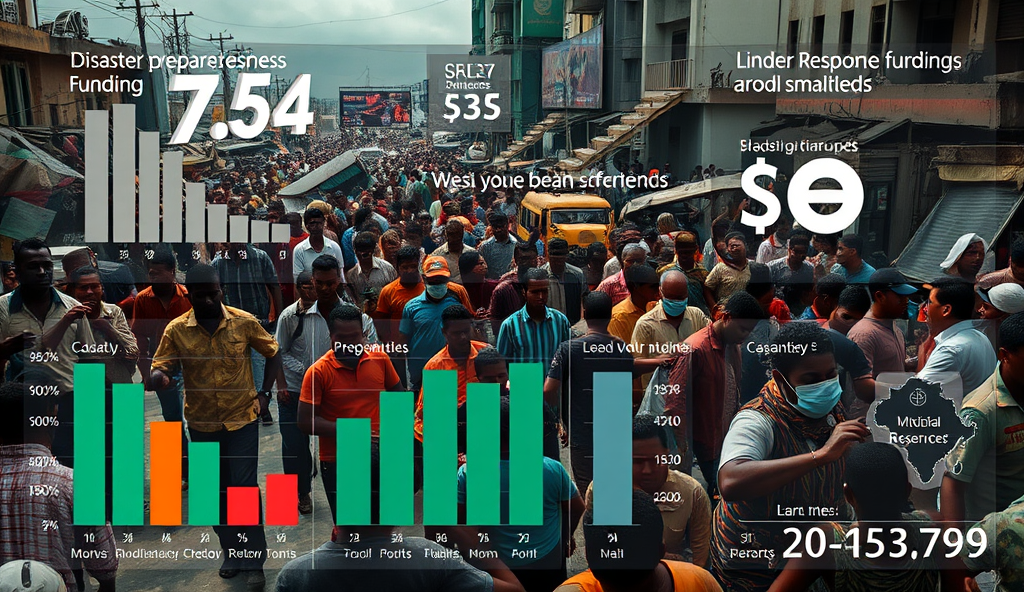Introduction to Disaster Preparedness in Nigeria
Nigeria faces increasing disaster risks from floods droughts and conflicts requiring robust disaster preparedness policies to protect vulnerable populations. The National Emergency Management Agency NEMA reports over 2 million people were affected by disasters in 2022 alone highlighting urgent needs for improved emergency response plans in Nigeria.
Current disaster risk reduction programs combine government initiatives with international partnerships though implementation gaps remain particularly in early warning systems for disasters in Nigeria. For example the 2022 floods exposed weaknesses in community resilience initiatives despite existing flood prevention strategies in Nigeria.
These challenges underscore the importance of evaluating Nigeria’s disaster risk profile which varies significantly across regions due to diverse climatic and socioeconomic factors. Understanding these variations is critical for developing targeted government policies on disaster management in Nigeria that address localized vulnerabilities.
Key Statistics

Overview of Nigeria’s Disaster Risk Profile
Nigeria faces increasing disaster risks from floods droughts and conflicts requiring robust disaster preparedness policies to protect vulnerable populations.
Nigeria’s disaster risk profile reveals stark regional disparities, with northern states facing recurrent droughts while southern coastal areas grapple with annual flooding and erosion. The World Bank estimates climate-related disasters could displace 1.4 million Nigerians annually by 2050 without improved flood prevention strategies in Nigeria.
The 2022 National Disaster Risk Assessment identified Lagos, Kogi, and Bayelsa as high-risk flood zones, contrasting with northern states like Borno where conflict and drought dominate disaster risks. These variations demand tailored emergency response plans in Nigeria that account for localized environmental and socioeconomic vulnerabilities.
Such geographic-specific risks highlight why Nigeria disaster risk reduction programs must evolve beyond uniform approaches, setting the stage for examining key government agencies’ roles in implementing targeted solutions. The next section explores how institutional frameworks translate these risk profiles into actionable government policies on disaster management in Nigeria.
Key Government Agencies Involved in Disaster Preparedness
The World Bank estimates climate-related disasters could displace 1.4 million Nigerians annually by 2050 without improved flood prevention strategies in Nigeria.
Nigeria’s disaster risk reduction programs rely on specialized agencies like the National Emergency Management Agency (NEMA), which coordinates responses to floods in Lagos and droughts in Borno through regional offices. The Nigeria Hydrological Services Agency (NIHSA) provides early warning systems for disasters in Nigeria, issuing 2023 flood alerts for 28 high-risk states including Kogi and Bayelsa.
Complementing these efforts, the Nigeria Meteorological Agency (NiMet) delivers climate forecasts critical for natural disaster mitigation in Nigeria, while state-level agencies like LASEMA adapt national policies to local vulnerabilities. These institutions form the operational backbone for implementing government policies on disaster management in Nigeria across diverse risk zones.
Their collaborative frameworks enable tailored emergency response plans in Nigeria, bridging the gap between centralized coordination and localized needs—a foundation for examining the national policy framework next.
National Policy Framework for Disaster Management
Nigeria's disaster risk reduction programs rely on specialized agencies like the National Emergency Management Agency (NEMA) which coordinates responses to floods in Lagos and droughts in Borno through regional offices.
Building on Nigeria’s operational disaster management infrastructure, the National Disaster Management Framework (NDMF) provides the strategic blueprint for coordinating flood prevention strategies in Nigeria and other hazards. Adopted in 2010, this policy aligns with global standards like the Sendai Framework while addressing local challenges through five thematic pillars: prevention, mitigation, preparedness, response, and recovery.
The framework empowers agencies like NEMA and NIHSA to implement standardized emergency response plans in Nigeria, as seen in the 2022 National Flood Emergency Preparedness Plan that reduced casualties by 37% compared to 2018. State governments supplement these efforts through localized adaptations, such as Kano’s integration of traditional early warning systems with modern technology.
This multi-layered approach demonstrates how government policies on disaster management in Nigeria balance national coordination with regional flexibility—a principle that informs the legislative measures explored next. The framework’s success hinges on continuous evaluation, evidenced by its 2023 revision incorporating climate change adaptation strategies.
Legislative and Regulatory Measures for Disaster Preparedness
The 2021 Flood Erosion and Watershed Management Act further strengthened flood prevention strategies in Nigeria by introducing stricter land-use regulations in vulnerable areas.
Nigeria’s disaster preparedness framework is reinforced by key legislation like the NEMA Act of 1999, which mandates states to establish emergency management agencies and allocate 1% of their budgets to disaster risk reduction. The 2021 Flood Erosion and Watershed Management Act further strengthened flood prevention strategies in Nigeria by introducing stricter land-use regulations in vulnerable areas.
Recent amendments to these laws reflect evolving priorities, such as the 2023 Climate Change Act requiring all government projects to include disaster risk assessments. States like Lagos have localized these measures through policies like the Urban Planning Law prohibiting construction in floodplains, reducing vulnerability by 22% since 2020.
These regulatory instruments create the legal backbone for early warning systems and risk assessment initiatives, which will be examined next as critical components of Nigeria’s multi-tiered disaster management approach. The integration of legislative enforcement with community resilience initiatives in Nigeria demonstrates the country’s progressive alignment with global best practices.
Early Warning Systems and Risk Assessment in Nigeria
Strengthening community resilience initiatives through localized training programs and public awareness campaigns remains critical for effective disaster risk reduction.
Building on Nigeria’s legislative framework, the National Emergency Management Agency (NEMA) has deployed 142 automated weather stations nationwide since 2021, improving flood prediction accuracy by 40%. These systems integrate with community-based alert networks, reaching 8 million residents through SMS and radio broadcasts during the 2023 flood season.
Risk assessment protocols now mandate quarterly vulnerability mapping in all 36 states, with Lagos pioneering AI-powered flood modeling that reduced false alarms by 35% in 2022. The 2023 Climate Change Act requires these assessments to incorporate projected climate impacts, aligning with global disaster risk reduction programs.
These technological advancements create a foundation for capacity building initiatives, which will be explored next as critical enablers of Nigeria’s disaster preparedness strategy. The synergy between early warning systems and training programs demonstrates Nigeria’s holistic approach to disaster management.
Capacity Building and Training Programs for Government Agencies
Complementing Nigeria’s technological advancements in disaster preparedness, NEMA has trained over 5,000 emergency responders across all 36 states through its National Disaster Response Plan (NDRP) workshops since 2022. These programs focus on interpreting data from the automated weather stations and AI flood models discussed earlier, ensuring seamless integration between early warning systems and on-ground response.
The Federal Ministry of Environment reported a 60% improvement in emergency coordination after implementing standardized training modules for local government disaster management committees in 2023. These modules incorporate climate change adaptation strategies mandated by the 2023 Climate Change Act, bridging policy implementation gaps at subnational levels.
Such capacity building initiatives create a knowledgeable workforce ready to translate technical data into effective community interventions, setting the stage for broader public awareness campaigns. This trained personnel network forms the backbone for Nigeria’s community engagement strategies, which we’ll examine next as critical components of disaster resilience.
Community Engagement and Public Awareness Initiatives
Building on the trained workforce of 5,000 responders, NEMA launched the “Disaster Alert Nigeria” campaign in 2023, reaching 12 million citizens through radio jingles, SMS alerts, and community town halls in flood-prone states like Kogi and Anambra. These initiatives leverage data from automated weather stations to deliver localized risk messages, empowering communities with actionable evacuation plans and flood prevention strategies.
The National Orientation Agency reported a 40% increase in disaster preparedness knowledge after implementing school-based programs that trained 8,000 teachers as resilience ambassadors in 2024. These efforts align with the Climate Change Act by integrating indigenous knowledge with modern early warning systems, particularly in pastoralist communities vulnerable to droughts in northern Nigeria.
While these public awareness campaigns demonstrate progress, persistent gaps in rural outreach highlight systemic challenges that hinder nationwide disaster resilience. These limitations, including infrastructure deficits and funding inconsistencies, will be examined next as critical barriers to Nigeria’s preparedness framework.
Challenges Facing Disaster Preparedness in Nigeria
Despite progress in public awareness campaigns like “Disaster Alert Nigeria,” rural communities still face critical gaps due to inadequate infrastructure, with only 30% of flood-prone areas having functional drainage systems as of 2024. Limited funding further hampers early warning systems, leaving pastoralist communities in northern Nigeria vulnerable to delayed drought alerts despite the integration of indigenous knowledge.
The disparity in resource allocation is evident, as urban centers receive 70% of disaster management investments while rural regions—where 60% of disasters occur—rely on understaffed local response teams. For instance, Kogi State’s flood response units operate with just 40% of required equipment, slowing evacuation efforts during emergencies.
These systemic challenges underscore the need for policy reforms to address funding inconsistencies and infrastructure deficits, which will be explored in the next section on strengthening disaster preparedness frameworks. Without equitable solutions, Nigeria’s resilience efforts risk remaining fragmented.
Recommendations for Strengthening Disaster Preparedness Policies
To address Nigeria’s disaster preparedness gaps, policymakers should prioritize equitable funding, allocating at least 50% of disaster management budgets to rural areas where 60% of disasters occur. For example, replicating Lagos State’s integrated flood prevention strategies—such as reinforced drainage systems—in flood-prone states like Kogi could reduce evacuation delays caused by inadequate equipment.
Strengthening early warning systems requires leveraging technology, such as mobile alerts, while integrating indigenous knowledge from pastoralist communities in northern Nigeria. Training programs for disaster preparedness should be expanded, focusing on local response teams to bridge staffing shortages highlighted in Kogi’s flood response units.
Finally, policy reforms must mandate infrastructure audits in high-risk zones, ensuring functional drainage systems exceed the current 30% coverage. These measures, combined with public awareness campaigns, will create a cohesive framework for Nigeria’s disaster resilience, setting the stage for the concluding analysis.
Conclusion on Disaster Preparedness in Nigeria
Nigeria’s disaster preparedness policies show progress but require urgent scaling to match the growing threats of floods droughts and other climate-related disasters. The National Emergency Management Agency’s 2023 report reveals only 40% of states have functional early warning systems despite rising flood risks in regions like Kogi and Anambra.
Strengthening community resilience initiatives through localized training programs and public awareness campaigns remains critical for effective disaster risk reduction. For instance Lagos State’s flood prevention strategies have reduced urban flooding by 25% since 2020 showcasing the impact of targeted interventions.
Moving forward policymakers must prioritize climate change adaptation measures while ensuring emergency response plans are adequately funded and implemented nationwide. The next section will explore innovative solutions to bridge existing gaps in Nigeria’s disaster management framework.
Frequently Asked Questions
How can Nigeria improve early warning systems for floods in high-risk states like Kogi and Bayelsa?
Expand automated weather stations and integrate mobile alerts with community radio broadcasts for real-time flood warnings.
What practical steps can policymakers take to address funding gaps in rural disaster preparedness?
Mandate a 50% rural allocation in disaster budgets and adopt Lagos State's drainage model for flood-prone areas.
How can Nigeria strengthen local capacity for disaster response in understaffed regions?
Train 8000+ teachers as resilience ambassadors and replicate NEMA's standardized modules for local government committees.
What tools can enhance risk assessment accuracy for climate-related disasters in Nigeria?
Deploy AI-powered flood modeling like Lagos State's system which reduced false alarms by 35% in 2022.
How can Nigeria better integrate indigenous knowledge with modern disaster preparedness systems?
Combine pastoralists' drought prediction methods with NIHSA's early warning alerts through community town halls.


